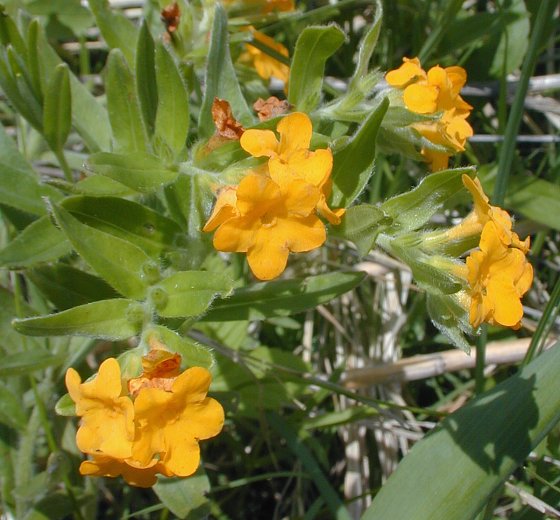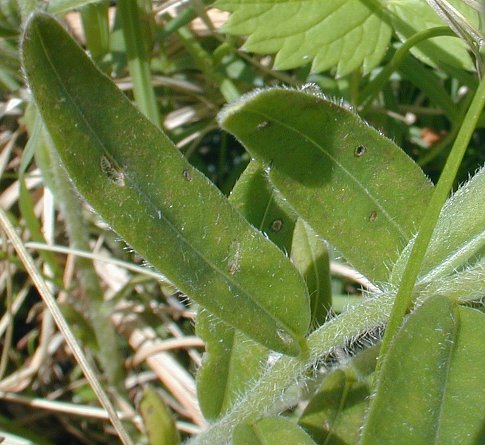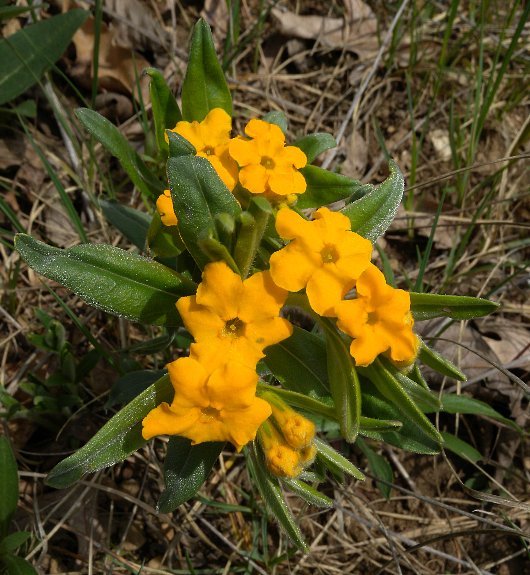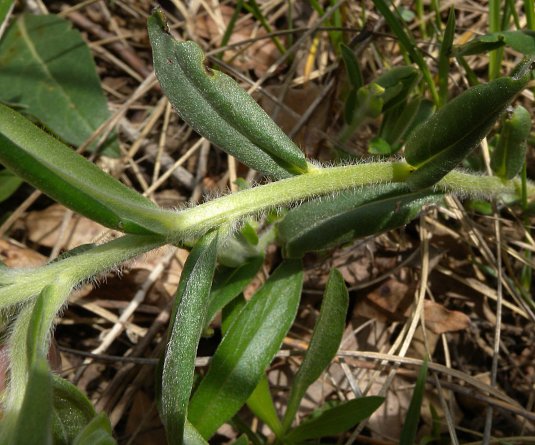Description: This perennial plant is about ½-1½' tall, sending up one or more leafy stems from the same root system. These stems are erect to ascending; they are unbranched below, while branching occasionally above. Individual stems are light green, terete, and hairy; these hairs are white and spreading. Alternate leaves occur along the entire length of each stem, differing little in size. These leaves are 1–1¾" long and ¼–½" across with prominent central veins; they are oblong or elliptic in shape, while their margins are entire (toothless) and ciliate. The leaf bases are sessile, while the leaf tips are bluntly acute to rounded. The upper leaf surfaces are medium to dark green and sparsely to moderately covered with short appressed hairs. The lower leaf surfaces are light to medium green and sparsely to densely pubescent; hairs are usually more common along the lower side of their central veins. The white hairs and pubescence of this plant provide it with a slightly hoary appearance, hence the common name. The upper stems terminate in showy clusters of flowers. Initially these flowers are arranged along short curled racemes, but somewhat later these racemes become longer and more erect.

Each flower spans about ½" across, consisting of a bright yellow to orange-yellow corolla with 5 lobes, a light green calyx with 5 long teeth, 5 stamens, and a 4-chambered pistil with a single style. The lobes of the corolla are rounded and spreading, while the base of the corolla is narrowly tubular and slightly funnelform. Both the calyx and its teeth are hairy; the teeth are linear-lanceolate in shape and up to ¼" long. The reproductive organs of this plant are heterostylous: some flowers have long styles and stamens with short filaments, while other flowers have short styles and stamens with long filaments. The pedicels of the flowers are very short (less than 3 mm. long). The blooming period occurs from mid-spring to early summer, lasting about 1 month for a colony of plants. Afterwards, the flowers are replaced by nutlets (4 nutlets per flower). Mature nutlets are 2-3 mm. long and ovoid in shape with pointed tips; their surfaces are hard, white, smooth, and shiny. The root system consists of a taproot. This plant reproduces by reseeding itself.

Cultivation:
The preference is full sun, mesic to dry conditions, and soil
containing loam, rocky material, or sand. The seeds of Hoary Puccoon
are
notoriously difficult to germinate, and its root system (consisting of
a taproot) is not readily divided. As a result, this plant is rarely
cultivated. This is a pity, because the flowers are very showy.
Range & Habitat:
The native Hoary Puccoon occurs throughout Illinois, except in some SE
areas of the state (see Distribution
Map). This conservative plant is occasional in high quality
natural areas (primarily upland prairies and savannas), otherwise it is
rare or absent. Habitats include black soil prairies, sand prairies,
hill prairies, upland savannas, sandy Black Oak savannas, and
limestone glades. This is the most common and widely distributed
species of its genus in Illinois.

Faunal Associations: The flowers attract bumblebees, digger bees (Synhalonia spp.), cuckoo bees (Nomada spp.), mason bees (Osmia spp.), bee flies (Bombylius spp.), butterflies (Vanessa spp., Papilio spp.), skippers (Erynnis spp.), and other insects (Robertson, 1929; Reed, 1993; Macior, 1967). The larvae of a long-horned beetle, Hemierana marginata ardens, feeds on Lithospermum spp., probably by boring through the stems and/or roots (Yanega, 1996). Because the foliage of Hoary Puccoon contains pyrrolizidine alkaloids, it can be considered more or less toxic to many herbivores (e.g., insects and mammals). There is some evidence, however, that this plant becomes relatively more abundant when White-tailed Deer and other mammalian herbivores are excluded from its proximity by fences (Ritchie et al., 1998). This implies that the foliage of Hoary Puccoon is probably grazed by White-tailed Deer and possibly other mammalian herbivores, notwithstanding its known toxicity.

Photographic
Location:
The photographs were taken at Loda Cemetery Prairie in Iroquois County,
Illinois, and a hill prairie in McLean County, Illinois.
Comments:
Because Hoary Puccoon (Lithospermum
canescens) begins to bloom during
the spring when other ground vegetation is relatively low, the brightly
colored flowers can be seen from a distance. The word 'puccoon' means
that this plant was the source of a dye at one time – a reddish color
that was used by Amerindians for pottery, basketry, and personal
ornament in various ceremonies. Hoary Puccoon is one of three native
puccoon species (Lithospermum
spp.) in Illinois that have flowers with
bright yellow or yellow-orange corollas. Unlike Fringed Puccoon
(Lithospermum incisum),
the corolla lobes of Hoary Puccoon are smooth,
rather than fringed, and it has wider leaves (exceeding ¼" across).
Compared to Hairy Puccoon (Lithospermum
croceum), Hoary Puccoon is a
smaller plant with smaller flowers – it also blooms earlier in the
year.
Unlike the preceding two species, the corollas of Hoary Puccoon are
sometimes yellow-orange, rather than yellow.